#casa de Austria
Explore tagged Tumblr posts
Text

King Felipe II of Spain. Unknown artist.
#monarquía española#reino de españa#reyes de españa#felipe ii#felipe el prudente#rey de españa#que viva el rey#casa de austria#austrias mayores#kingdom of spain#house of habsburg#king of spain
16 notes
·
View notes
Text
youtube
The Female Perspective:Mariana of Austria
The story behind her most famous paintings.
Video by: Museo National del Parado
#history#mariana de austria#house of habsburg#spain#17th century#art#please like and reblog#habsburg#historical figures#her story#my girl#my roman empire#facts people should know#interesting facts#fun facts#casa de austria#austria#queen of spain#Youtube
14 notes
·
View notes
Text
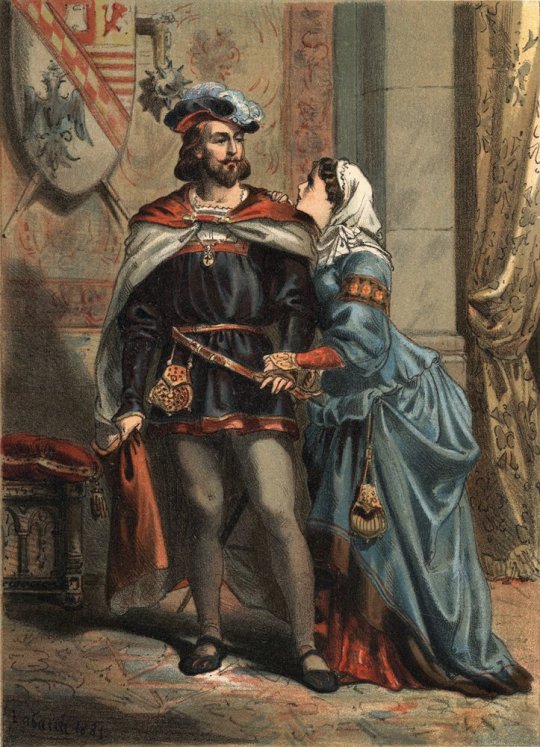
Joanna of Spain known as the Mad (1479-1555), Queen of Castile and her spouse Philip the Handsome (1478-1506), King of Castile and Archduke of Austria in 'El Culto de la Hermosura' by Juan Justo Huguet.
#monarquía española#reyes de españa#juana la loca#reina de españa#viva la reina#casa de trastámara#kingdom of spain#house of trastamara#felipe el hermoso#rey de castilla#archiduque de austria#casa de austria#dinastía habsburgo#philip of habsburg#philip the handsome#joanna the mad#royal couple#engraving#king of castile and león#kingdom of castile#house of habsburg#royalty#el culto de la hermosura#juan justo huguet
17 notes
·
View notes
Text
Casa De Papel

#casa de papel#artists on tumblr#art#casa de austria#Italia#gomorra#espagne#Spain#Mafia#Braquage#Gangsta#CasaDePapel#MoneyHeist#LaCasaDePapel#Netflix#TheProfessor#BellaCiao#MoneyHeistFans#TokyoCasaDePapel#NairobiCasaDePapel#Heist#MoneyHeistArt#CasaDePapelQuotes#MoneyHeistSeason#TeamProfessor#CasaDePapelFan#MoneyHeistLovers#BellaCiaoCasaDePapel#NetflixSeries#MoneyHeistFamily
1 note
·
View note
Text
Today is his birthday

Philip IV (1605–1665) in Parade Armor
Artist: Gaspar de Crayer (Flemish, 1584–1669)
Date: circa 1628
Medium: Oil on canvas
Collection: Metropolitan Museum of Art, New York City, NY, United States
Philip IV of Spain
Philip IV (Spanish: Felipe Domingo Victor de la Cruz de Austria y Austria, Portuguese: Filipe; 8 April 1605 – 17 September 1665), also called the Planet King (Spanish: Rey Planeta), was King of Spain from 1621 to his death and (as Philip III) King of Portugal from 1621 to 1640. Philip is remembered for his patronage of the arts, including such artists as Diego Velázquez, and his rule over Spain during the Thirty Years' War.
20 notes
·
View notes
Text
La Confederación Suiza y su importancia histórica
La Confederación Suiza y su importancia histórica #aperturaintelectual #vmrfaintelectual @victormanrf @Victor M. Reyes Ferriz @vicmanrf @victormrferriz Víctor Manuel Reyes Ferriz
*Fotografía creada con Microsoft Designer AI 01 DE FEBRERO DE 2024 La Confederación Suiza y su importancia histórica POR: VÍCTOR MANUEL REYES FERRIZ De manera histórica hemos comprendido que la Confederación Suiza toma una postura neutral en muchos ámbitos relacionados con política, de hecho, esta neutralidad es un pilar fundamental e indiscutible de su política exterior que tiene también un…
#AperturaIntelectual#vmrfaintelectual#ACNUDH#ACNUR#Altdorf#Arnold von Melchtal (Unterwalden)#Austria#Banco Mundial#Basilea#Berna#Casa de Habsburgo#CEPE#Confederación Helvética#Confederación Suiza#Congreso de Viena#Cruz Roja Internacional#Eidgenossen#FAO#Foro Económico Mundial#Ginebra#Guerra Suaba#IIMM#IIMP#Juramento Rütli#La Confederación Suiza y su importancia histórica#Napoleón Bonaparte#OIM#OIT#OMC#OMM
0 notes
Text
Lucky girl part five
Summary: it's race time in Barcelona, the home of Lucky and she can't wait for the Spanish GP and what comes after.
Sorry for the wait but I had a lot going on and then I decided to just wait until after the race to see the results. So it can be a accurate to the weekend. This not proof read, so sorry if there's any mistakes.
This is the last one sadly. I honestly wasn't sure how to end this so it might not be that amazing 😓. Also there is likely to be little things that come out if I get inspired or tweets and stuff I didn't post so look out if that interests you but lucky girl is finished, thank you everyone who enjoyed this short series. I didn't expect many people to like it but I was surprised.
yourusername • stories

charles_leclerc I can't wait to see you mon chéri ❤
yourusername get here soon and you will 😘
Bestfriend1 OMG WE HAVE TO GET TOGETHER SOON
yourusername YES OF COURSE I'LL TEXT YOU
Bestfriend2 you're back home, sleepover soon ? 🤔
yourusername ohh yes, I have so much to tell you guys
Bestfriend2 about charles? 😏
yourusername 🤭
Username1 you are so beautiful 🥰
Username2 ¿Es usted de Barcelona? Are you from Barcelona?
yourusername Nací en Barcelona Fue mi primer amor ❤ I was born in Barcelona it was my first love
y/b/username tráeme algo de comida de camino a casa bring me some food on the way home
yourusername ¿Es así como se pide algo? 🤨 Is this how you ask for something?
y/b/username Me dejaste y me perdí a mi piloto favorito ganando su carrera en casa 😐 you left me and I missed my favorite driver winning his home race yourusername Estás alargando esto 🙄, ¿qué quieres? You're dragging this out, what do you want?
y/b/username Cualquier cosa está bien pero yo también quiero churros 😋 Anything is fine but I want churros too.
Username3 I want to visit there 😭
Scuderiaferrari we are ready to race in this beautiful city 🇪🇸
Username5 happy you're home
Username7 that fruit looks so good




1,457,987 likes
charles_leclerc Difficult weekend for the team. We have to do better in Austria. But first I will be spending time with loved ones and refresh my mind for the race next week.
yourusername Je suis si fière de toi, ma chérie, tu t'es si bien débrouillée. J'ai hâte de te montrer ma ville. I'm so proud of you, darling, you've done so well. I can't wait to show you my city.
* Liked by creator
Scuderiaferrari enjoy your time, we will come back stronger in Austria 💪🏼
Username19 what a....interesting race for Ferrari today 🤕😪
Username16 not charles posting a photo of max maxplaining 😭
charles_leclerc • stories
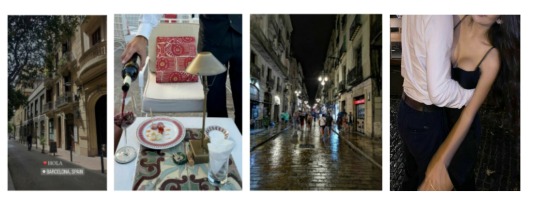
arthur_leclerc Je ne sais toujours pas pourquoi elle voudrait sortir avec toi 🤨 I still don't know why she would want to go out with you
Username12 omg they are so cute
Username29 looked at my man and sighed
Username17 congrats Charles for bagging the most gorgeous girl in the world
Liked by creator

yourusername • stories

Bestfriend1 Chica esto es una locura para publicar un 8 de la mañana 😭 Girl this is crazy to post on an 8 in the morning.
Friend2 oh...ok this is some despicable behavior for 8am 🤥
Y/b/username OMG WHY WOULD YPU POST THIS 🤮🤮🤢🤢
charles_leclerc ❤
yourusername 🥰
charles_leclerc • stories

yourusername 🤭
charles_leclerc Te quiero mi amor ❤ I love you my love
pierregasly Vous êtes bizarres de poster des pièges à soif les uns des autres à 8 heures du matin 😟 You guys are weird for posting thirst traps to each other at 8am.
Arthur_leclerc 😧
charles_leclerc how's that for rizz 😆
y/b/username AHHH MY EYEEEES 🤮
charles_leclerc sorry y/b/n 😅
Username3 AINT NO WAY LMAO 🤣
Username11 Ferrari is gonna put you in pr jail 😭
Username18 OH...oh wow....

yourusername and charles_leclerc I'm so lucky to have found a love like this in my life. Thank you to y/b/n for making this happen. I love you my love and I'm so lucky to receive your love in return.
y/b/username thank you for the shout out but no more pda🙅🏻♂️, I can't do it anymore 🤢
Username124 I love them so much
Bestfriend1 love you lucky and you too Charles 😒
arthur_leclerc congrats ig 😕
youusername you don't sound very happy?
arthur_leclerc why did you have to choose....him tho? 🙁
charles_leclerc you know I can see this comment right?
arthur_leclerc So? she's way out of your league
Username27 we about to get the girlfriend effect goodbye cloud pants
charles_leclerc what's wrong with my pants? 🙁
Username27 everything.
charles_leclerc @yourusername baby are my pants that bad ☹?
yourusername oh they aren't THAT bad Charlie 😅
Username27 but they ARE that bad 🤥
yourusername well don't tell him that 😓
charles_leclerc 😞
yourusername don't worry baby we will work on it okay 🥰
charles_leclerc okay 😍
Username1 what is this comment section 😭
Username16 silly season in full affect
Username3 Charles is a simp 🤣
Username6 I would be too if I was dating lucky
Username5 con😭grat😭u😭lat😭ions Charles
Username45 I can't believe uber boy got lucky 🙄😒
Username4 oh to be dating charles 😪
Username1 oh to be dating lucky
Username11 do you guys need a dog? I can bark 🐕🧎🏼♀️
charles_leclerc Already got one 😍
Username11 what do you mean by that 🤨
scuderiaferrari wow this totally sfw post is so lovely, congratulations to the new couple 😍
Username21 help 😭😭
Username8 admin what about charles and luckys' stories 🤣
scuderiaferrari admin has no idea what you're talking about 😆 I definitely have NOT seen post that could be considered nsfw AT ALL 😃 especially not at 8 IN THE MORNING HAHAH 🤣
Username37 IJBOL ferrari admin is freaking out 😭
#charles leclerc imagine#charles leclerc smau#charles leclerc x female reader#charles leclerc x reader#cl16 imagine#cl16#f1 imagine#smau#f1 smau#charles leclerc
164 notes
·
View notes
Text
The Soviet Revolution of October 1934
The Second Spanish Republic is a figure in history which tends to be overly glorified by the contemporary Spanish left, including some excessively folklorist communists, as a desire to look through history for any instance when opposition to the monarchy and reactionaries was the hegemonic position. After 40 years of a fascist dictatorship, and 46 years of a liberal democracy that has exposed social-democracy's bankruptcy, the Second Republic is a time when the PCE (Communist Party of Spain) was a force to be reckoned with, at least compared to today, with a few hundred thousands along its lines. Despite the Second Republic lasting from 1931 to 1936, the aspects that tend to be glorified are the times of the Popular Front, the electoral alliance from the PSOE to the PCE that won the February 1936 elections, and ruled until the coup d'etat of July 1936. Perhaps unconsciously, perhaps consciously, the years of 1932-1935 tend to be not forgotten, but minimized.
This is because the Second Republic was not a "popular" state, it wasn't even nominally progressive for half its history. And again, in an exercise of willful ignorance, when its repressive episodes are discussed, most tend to focus on the Black Biennium, as historiography knows it, the two years (1933-1935) when the right governed under the CEDA coalition, which included falangists, monarchists, even Carlists. But the history of repression in the Second Republic begins not even a month after its constitution was ratified. The Castiblanco incidents of December 1931 saw a few day workers killed by the police during a peaceful demonstration asking for work, afterwards it turned violent and 4 policemen were lynched by the workers. That same week, in the Arnedo incidents, the 5th of January 1932, the police shot into a crowd of striking workers in the town's square, renamed recently to Republic Square. 11 people were killed, two of them a mother and his 4 year old son, another a 70 year old woman. 5 others were permanently left unable to work. Just a year later, in January of 1933, 19 men, 2 women and a child were massacred in the Casas Viejas Incident, after an attempted uprising and occupation of the police quarters.

The Second Republic was always an anti-worker state, from its very beginnings. Regardless of what its constitution said, the social advances of the republic were lubricated with worker's blood.
Let's set some context for the subject of this post: The PCE, section of the Third International, found itself at risk of dissappearence at the end of the 1923-1930 dictatorship. It only really began to recover after José Diaz was elected General Secretary in 1932, it had about 1.000 members at this time, and by 1934 it had risen to 15.000 members, without counting the members of its youth wing. Internationally, the meteoric rise of fascism was unignorable. Nazi-fascism and fascism had seized power in Germany and Italy, and similar tendencies in Portugal and Austria were also in power, in the form of Salazar's Estado Novo in the former and Dollfuß' austrofascism in the latter, himself killed by outright nazi-fascists. Spain had its supposedly progressive Republic, of course, but it did not prevent the JONS to be founded in 1931 and the Falange in 1932, which during the civil war would merge into the infamous FE de las JONS, the Spanish Falange of the National-Syndicalist Offensive Juntas (The Falange is still a legal party now!). The leader of the CEDA, which would later govern during that Black Biennium I mentioned earlier, attended the Nürnberg Congess of 1932, where the pictures of those massive nazi-fascist rallies come from.
The 4th of October, 1934, 3 CEDA ministers had been chosen to enter the government, and in response, a strike, called the Revolutionary General Strike, was called for the following day, the 5th of October, 90 years ago today. The organization of this strike was done between the PCE, CNT (national confederation of workers, an anarcho-syndicalist union) and PSOE. The will to call the strike was not equal, however. The meeting minutes of the evening and night of the 4th show that the CNT was not very convinced of the strike and flip-flopped a lot, while the PSOE only decided to support the strike once it became impossible for them not to. The PCE, on the other hand, had already spent a few months warning of this, and preparing.
Barely a month before October, the police found a shipment of weapons going from the port of Gijón to Mieres, the future epicenter of the revolution. There were three armed shipments, and while the other two reached their destination, the third one being found almost lead to Indalecio Prieto, of the PSOE, being arrested. As a result, the weapon stashes in various places in Madrid (Casa del Pueblo, Ciudad Universitaria, Cuatro Caminos). These weapon stashes were supposed to supply the revolutionary strike in Madrid, and since they were found, the nascent revolutionary center was stillborn, since it was unable to arm itself. These same weapon stashes would later be replenished and used by the first militias of Madrid in the July 1936 coup d'etat
Nevertheless, the call for a strike was distributed at 6:00 of the 5th, but it was only heeded in Asturias, Madrid, Vizcaya, Cataluña, plus a few weak points (Cantabria, Aragón, Alicante, León, Palencia, Málaga). The reason the call was not heeded in broader parts of the country was because the agricultural day workers, predominant throughout the central meseta and south had already carried out their own strike that same year. They were recovering, they feared the repression that was still fresh in their minds, and it did not help that the predominant political organization among them, the CNT, took too long to support the strike, they simply were not prepared. It is impossible to understate how crucial this point is. The greatest worker strata in Spain were unable to be reached by the call to a revolutionary strike, for reasons related to the situation, but because of the inability of the PCE of this time to truly penetrate the social majority.
At any rate, the Revolutionary General Strike was not ignored everywhere, from these days comes this picture of Madrid's very center devoid of people, withholding their work, but impotent to do anything more:
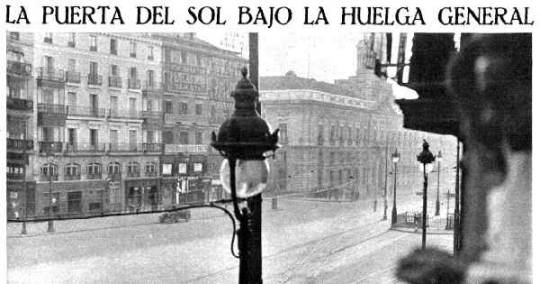
The Second Republic did not hesitate to stifle this strike, using planes and naval and land artillery. Once again, Spanish capital required trails of this country's reddest blood to line the streets, not shying away from employing the help of fascists such as the up-and-coming General Franco, sent to repress the workers of Asturias, where the strike was incandescent with revolutionary impetus. Before talking about Asturias, I won't ignore the other places where the strike was also popular. In Guipúzcoa and Vizcaya, The Basque Country, repression was just as bloody, executed by the Guardias de Asalto (Assault Guards), killing 40 workers in Vizcaya. There, the "Revolutionary Committee of Vizcaya", led by the UGT, was quickly dissolved. In Cataluña, a Catalan state was quickly declared, lead by the bourgeois Esquerra Republicana de Catalunya (Catalonian Republican Left), but was just as quickly put down with another 40 dead.
Asturias is another story, one that lasted for two weeks. It isn't much, but in those two weeks, the Spanish proletariat came the closest to holding political power, closer than any other time in its history. There, the strike did have a pre-existing entity capable of organizing the strike: the Worker and Peasant Alliance formed the 1st of April of that year, an armed force influenced by UGT, CNT (only present in the Asturias alliance), the Asturian Socialist Federation, and the PCE, whose militants often represented the most advanced elements of these alliances, but simultaneously relatively few. These alliances were heavily inspired by the Soviets, and often talked about the Sovietization of industry and of opposing colonialism. While this is evidence that it really was an attempted revolution, and that they were inspired by the Bolshevik revolution, their attempt to imitate the USSR's Soviets instead of learning from them was one of the many factors that provoked its defeat. Despite the name, the Worker and Peasant alliances were never as strong among peasants, not a lot of effort was put into it.
Another organization that was relevant during the October Revolutionary Strike were the Workers and Peasant's Antifascist Militias (MAOC in Spanish), a paramilitary militia, founded by Antonio Modesto, a member of the PCE educated in the USSR, he'd later become famous within the republican side of the Civil war. These militias were few but competent, they counted 150 members in Madrid and Asturias each, and while the Asturias militias participated in the revolution, the ones in Madrid sabotaged the roads and railways leading north, to avoid reinforcements getting to Asturias. These militias would later be the base from which the Fifth Regiment was created, in July 1936, to commence the defense of Madrid from the coup d'etat and fascist assault.
In Asturias itself, the proletariat lunged forwards as fast as it could, growing from the town of Mieres and the Nalón basin, to every other mining basin, taking the cities of Oviedo and Gijón by force. The National Guard's many stations were occupied and raided for arms and ammunition, they already had access to explosives from mining equipment. At one point, they felt strong enough to consider a march on Madrid, and even proclaimed the Asturian Socialist Republic. In what sometimes was called the Asturian Commune, a reference to the Paris Commune of 1871, production was controlled by workers, protected by a combatant force of up to 30.000 strong. Production in the metallurgical and mining industry was organized through attempts at imitation of the Soviets, as I mentioned. The Asturias branch of the Central Bank of Spain was expropriated as well, substituting money for a system based on coupon-like vouchers. However, the Revolutionary Committee leading the revolution was dissolved and reformed 2 times in those weeks, without counting the third dissolution that came with capitulation, although that committee did begin to plan the region's economy, the short span of time not really being enough to judge its efficiency.
The revolutionaries' retreat only began once the Republican government, as anti-worker as ever, followed the advice of generals Franco and Godet to deploy the Tercios de Regulares and the African Legion, two battle-hardened groups of the military not afraid to be brutal against the workers. While they advanced, for instance, they executed every wounded solider or civilian found in captured hospitals. In Asturias, more than a thousand workers were killed in combat or executed, and in total throughout Spain, the strike concluded with 2.000 dead, 7.000 wounded, and 40.000 imprisoned, for the crime and sin of daring to govern oneself and to end the exploitation of man by man. One of these dead workers stands out among the rest in popular culture nowadays, a member of the PCE's youth wing: Aida de la Fuente. She was only 19 when she joined the revolution in motion, the daughter of the PCE's founder in Oviedo, and she was known to be an exceptionally brave and dedicated communist. The 13th of October, a few hours after being seen distributing leaflets to civilians urging them to join the revolution, she found herself almost alone in Oviedo, trying to hold off the Legion's advance by manning a machine gun, and she managed to do so for a few hours. She was reached nevertheless and when a Legion commander asked her to surrender, she only responded by shooting back. Seconds later she was killed, and later found in a common grave. The counter-revolutionary press attempted to paint her murder as one committed by her own comrades, even claiming rape, but this was disproved by a journalist who risked his own life, and the testimony of the very legionary who executed Asturias' reddest rose.

The Asturias revolution was, for all its merits and promise, a stillborn revolution. The Communist Party did not have effective direction over the mass of proletarians involved in the revolution, let alone the even greater mass who, for one reason or another, did not meet the conditions necessary for attempting to seize power. The strike's organization was insufficient and thwarted in part, and militarily, the objective Indalecio Prieto was tasked with of securing support among the military officials, along with the general inferiority of the Asturian revolutionaries compared with the elite bodies of the military, meant there was no realistic chance of success. The strike was not even fully effective within Asturias, for instance, the livestock peasants known as vaqueiros, of the southwest, did not ever really have their influence. The PSOE militants who did exist in the region got into trucks and left for Oviedo, while a column of revolutionaries from León, the other side of the mountain range, tried to take Cangas del Narcea, the main town of the region, but they were routed by the National Guard.
After the defeat, 121 revolutionaries exiled themselves to the USSR, mostly communists but also accompanied by a handful of anarchists. There, they received education as cadres, who later returned to Spain before and during the civil war, providing invaluable expertise. Others chose to exile in Portugal or France, but both those countries repatriated them to be imprisoned in Spain.
During the negotiations between the Popular Front and the PCE for the 1936 elections, the main requisite they demanded in order to join was the amnisty of these tens of thousands of imprisoned workers, from the October Revolution and from the myriad of episodes of repression during the Black Biennium. To achieve this amnisty, they were also helped by International Red Aid, a political Red Cross founded by the International in 1922. They, along with the PCE, also provided a pension for the families of the many imprisoned. During the civil war, the Red Aid played an important role in the republican side's medical centers.
This episode is often forgotten when talking about the civil war, but it was one of the many reasons fascists were allowed to take power. Spain's risk of sovietization was an internationally recognized risk, so when the opportunity came, Spanish, English, French, and US capital very gladly did everything they could to hamper the Republic
The lesson from the October Revolution of 1934 is clear. Without country-wide preparation, without a proper analysis of your own conditions, and without achieving social alliances, any revolutionary struggle is bound to fail. The lack of support in the much greater agricultural areas, the rushed planning and failed planning everywhere but Asturias, partially, the PCE's still weak influence in most organizations or regions, all of this meant that, whatever the Spanish proletariat learnt in that Revolutionary General Strike, was bound to be written in sweat and blood. The point of commemorating this bittersweet memory is not to dwell on what could have been, nor to recreate the MAOCs. It's to remember that a revolution is always a couple of bad decades away, and that not building consciousness and preparing structures for it will only mean more unnecessarily murdered workers. It's to ensure that, next time red October is around the corner, it will not be premature. The strength of the working class, our class, the social majority, lies not in the number of victories and defeats, but in the very fact of our fight, explicit and implicit. It lies in the fact that, for as long as classes based on exploitation exist, class conflict is unavoidable.
Many political forces nowadays, which one might call opportunist, will try to draw parallels between that autumn of 1934 and today, exhorting "unity of the left". The only unity that's truly revolutionary, the only unity that will not cause the subordination of our class interests to electoral or immediatist growth objectives, is the unity of the entire working class under a single Communist Party. The PSOE, even with its very involved marxist wing, characterized by the likes of Largo Caballero or Indalecio Prieto, only ever concieved of the Revolutionary General Strike as a means to the end of preventing those CEDA ministers from being appointed and in turn, gain more electoral and institutional strength. They also happened to be a relevant force because of their sheer number of members.
98 notes
·
View notes
Note
If one King is hosting another King for supper [if it matters, they're celebrating a wedding between their children], how would the seating work? It's a great big public feast, so where would the Kings, Queens, and Heirs all sit at the table? Is there some sort of specific order to it?
Usually the table would be U shaped, with the host monarch and their guests seated at the top table with people on either side. However, an example from Queen Victoria's Golden Jubilee dinner had the guests seated at different tables. You can see from the guest list that there were quite a few monarchs, heirs and consorts and ambassadors invited - from a plan in the National Archives:
Queen’s Table
The Queen The Prince of Naples Princess of Wales Grand Duke of Hesse Grand Duchess Elizabeth Feodorovna of Russia Prince Albert of Prussia, Regent of Brunswick Grand Duchess of Mecklenburg-Strelitz Grand Duke Serge of Russia Grand Duchess of Hesse Crown Prince of Siam Empress Frederic The Archduke Francis Ferdinand of Austria
Prince of Wales’s Table
Prince of Wales Princess Christian of Schleswig-Holstein Grand Duke of Mecklenburg-Strelitz Princess Frederica of Hanover The Prince of Japan Princess of Bulgaria Duc d’Auerstadt (France), Special Ambassador Princess Henry of Prussia Prince Waldemar of Denmark Duchess of Saxe-Coburg and Gotha Prince Henry of Prussia The Princess of Naples
Duke of Saxe-Coburg and Gotha’s Table
Duke of Saxe-Coburg and Gotha Duchess of Connaught Prince Rupert of Bavaria Duchess of York Duke of Oporto Princess Victoria of Wales The Hon. Whitelaw Reid, United States Special Ambassador Hereditary Princess of Saxe-Meiningen Prince Frederick Augustus, Duke of Saxony Princess Louise (Duchess of Fife) Grand Duke Cyril of Russia Princess Louise (Marchioness of Lorne)
Duke of Connaught’s Table
Duke of Connaught Duchess of Albany Duke Albert of Wurtemberg Princess Charles of Denmark Crown Prince of Montenegro Prince Charles of Ligne, Belgian Ambassador Extraordinary Duke of Sotomayor, Spanish Special Ambassador Monsignore Sumbucetti, Archbishop of Corinth, Papal Envoy Hereditary Grand Duke of Luxemburg Princess Adolphe of Schaumburg-Lippe Prince Eugene of Sweden and Norway Princess Beatrice, Princess Henry of Battenberg
Duke of York’s Table
Duke of York Princess Frederick Charles of Hesse Prince of Bulgaria Princess Louis of Battenberg Prince Alfred of Saxe-Coburg M. de Staal (Russian Ambassador) His Excellency Chang Ying Hun (China) Prince Mohammed Ali Pacha of Egypt Prince Amir Khan of Persia Princess Victoria of Schleswig-Holstein Prince Charles of Denmark Duchess of Teck
Duke of Cambridge’s Table
Duke of Cambridge Princess Feodore of Saxe-Meiningen Prince Philip of Saxe-Coburg Prince Edward of Saxe-Weimar Duke of Teck Munir Pacha (Turkish Envoy) Count van Lynden Duchess of Buccleuch (Mistress of the Robes) Prince Aribert of Anhalt Princess Hatzfeldt, Mistress of the Robes (to The Empress Frederic) Prince Frederick Charles of Hesse Princess Aribert of Anhalt
Marquis of Lorne’s Table
Marquis of Lorne Count de Casa Valencia (Spanish Ambassador) Prince Adolphus of Teck Lord Chamberlain Prince Francis of Teck Baron von Pawel Rammingen Anthopoulo Pacha (Turkish Ambassador) Prince Alexander of Teck Min Young hwan (Corean Envoy) Duke of Fife Prince Albert of Schleswig-Holstein Countess Victoria Gleichen
Prince Christian of Schleswig-Holstein’s Table
Prince Christian of Schleswig-Holstein Countess Feodore Gleichen Prince Hermann of Saxe-Weimar Count Deym (Austro-Hungarian Ambassador) Prince Louis of Battenberg Herr von Brauer M. de Courcel (French Ambassador) The Marquis of Salisbury Mr Hay, United States Ambassador General Ferero (Italian Ambassador) The Archbishop of Finland The Lord Steward Prince Christian Victor of Schleswig-Holstein Count Hatzfeldt (German Ambassador) Prince Adolphe of Schaumburg-Lippe Princess Victor of Hohenlohe
22 notes
·
View notes
Text

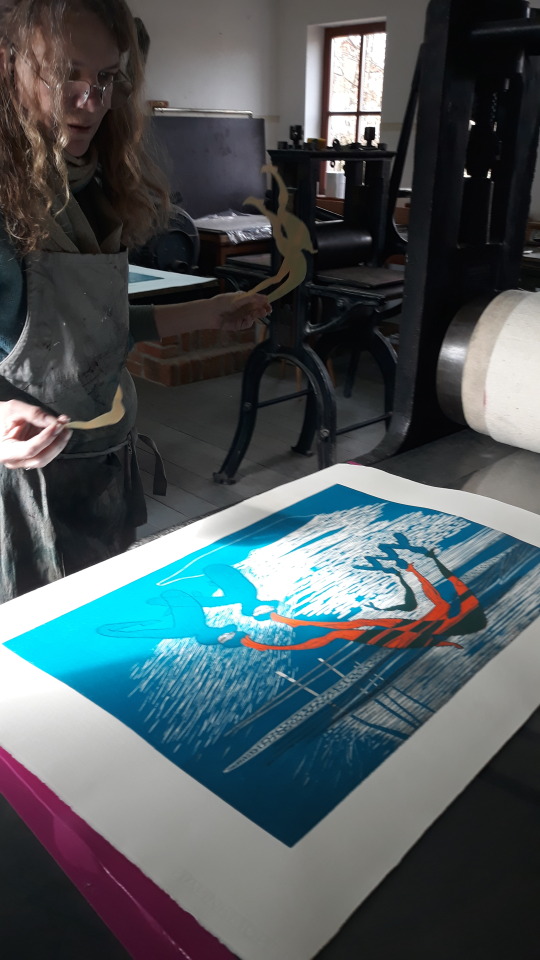
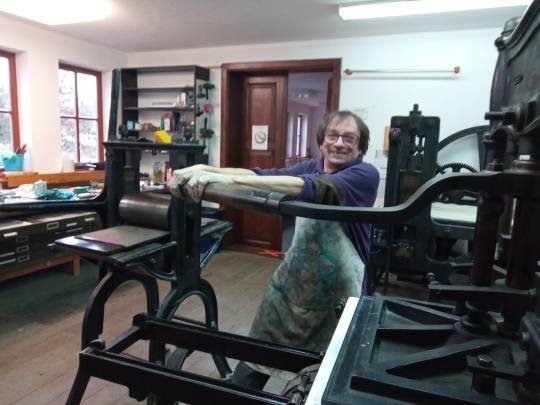
Residencia en Künstlerdorf Neumarkt, Austria.
Desde el día 15 de febrero los artistas Barbara Viel y Marcos Vidal están realizando una residencia artística en el Künstlerdorf Neumarkt en el sureste de Austria. Situado en la región de Burgenland Neumarkt den Raab es un lugar de encuentro de creadores desde hace casi 60 años. Los residentes de la zona impidieron la demolición de una de las casas tradicionales que aún se conservaban y decidieron después ponerlas a disposición de artistas para que pudieran trabajar en ellas. Escritores como el nobel Peter Handke pasaron periodos creativos allí. También artistas visuales como; Gerhard Roth, Martín Kippenberger, por mencionar los más conocidos. Algunos han impartido talleres en el Künstlerdorf Neumarkt, famoso por sus talleres de verano, como Eva Möseneder. Viel y Vidal están desarrollando sus trabajos sobre planchas de madera y cobre en el taller de grabado, gracias esta última con quien han podido compartir unos días en el taller. Este hermoso lugar ha sido adquirido por el Gobierno Regional de Burgenland, sus casas son patrimonio, y ofrece un entorno acogedor gracias a un gran equipo humano, a destacar la labor de Petra Werkovits, que ha hecho posible esta experiencia.
#marcos vidal#art#marcosvidal#arte#austria#residence#Künstlerdorf#Neumarkt#Burgenland#Air#printing#print#woodcut#etching#engraving#printmaking#contemporary art#barbaraviel
70 notes
·
View notes
Text

Portrait of young Charles of Habsburg. By Josef Kiss and Friedrich Mayrhofer.
#josef kiss#friedrich mayrhofer#reino de españa#casa de austria#infantes de españa#carlos de austria#infante de españa#charles of habsburg#infante of spain#house of habsburg#kingdom of spain#full length portrait#art#portrait#full-length portrait
18 notes
·
View notes
Text
“Lo que Dios obra en su interior durante las horas de meditación no se percibe a simple vista. Pero se supone una gracia tan grande, que todas las demás horas de la vida están agradecidas e influidas por este tiempo de meditación”
Edith Stein

Fue una filósofa, mística religiosa, mártir y santa alemana de origen judío nacida en Breslavia imperio alemán hoy Polonia en octubre de 1891.
Nació en el seno de una familia judía, su padre era dueño de un aserradero y fue la séptima hija de un total de 11 hijos del matrimonio, y como tal vivió las raíces hebreas familiares y el nacionalismo prusiano.
Desde muy temprana edad mostró especial interés por la historia y la literatura alemanas y de las grandes figuras de la música como Bach, Mozart y Wagner.
A la edad de 15 años experimentó una etapa de ateísmo y crisis existencial, causada por el suicidio de dos de sus tíos y la falta de respuesta de la religión al tema del más allá. Abandona el colegio y se traslada a Hamburgo para asistir a su hermana Elsa quien iba a tener un hijo.
En 1913, la lectura de “las investigaciones lógicas“ de Husserl le abrió una nueva perspectiva en vista a su orientación objetivista, por lo que decide trasladarse a Gotinga a terminar los cursos universitarios y por ejercer Husserl allí su magisterio.
En Friburgo, en 1917, aprobó con la calificación de summa cum laude su tesis doctoral titulada “Sobre el problema de la empatía”, tema que le sugirió Max Scheler, con el que inició sus obras filosóficas.
Como estudiante de filosofía, fue la primera mujer que presentó una tesis en esta disciplina en Alemania.
Gracias a su amigo Georg Moskiewicz, Edith Stein fue aceptada en la sociedad de la filosofía de Gotinga, que reunía a los principales miembros de la fenomenología naciente como Edmund Husserl, Adolf Reinach y Max Scheler, y durante estos encuentros una correspondencia personal y profunda con el filósofo, ontólogo y teórico literario Roman Ingarden así como con el filósofo francés de origen ruso Alexandre Koyré.
Durante la primera guerra mundial Edith Stein decidió regresar a Breslau, tomó cursos de enfermería y trabajó en un hospital austriaco. Cuando el hospital fue cerrado, Edith regresó a reanudar sus estudios filosóficos con Husserl obteniendo un doctorado en la Universidad de Friburgo.
Una vez obtenido el doctorado, se enroló en la cruz roja en donde fue enviada a ocuparse de los enfermos de problemas infecciosos y trabajo en salas de operaciones, obtuvo una medalla por su dedicación y debido a lo precaria de su condición de salud fue enviada a su casa y no la llamaron mas.
Estas experiencias con los jovenes que morían a muy temprana edad de todas partes de Europa del Este, la marcaron profundamente, y poco a poco fue acercándose a la fé católica, la entereza con la que su amiga Ana Reinach, sobrellevó la muerte de su joven esposo, una vez que ambos fueron bautizados así como su acercamiento a los escritos de Santa Teresa de Jesús, y la entrada en una iglesia católica de Frankfurt en donde reparó la presencia del santísimo, hizo que se decidiera a ser bautizada en enero de 1922.
Durante esta época, dedica parte de su vida a la docencia con poco éxito para ofrecer cátedra en universidades, por lo que se dedica a dar clases particulares de fenomenología y ética en Breslau y en ocasiones pronuncia conferencias en congresos de pedagogía en Alemania, Austria y Suiza.
En octubre de 1933 ingresa al Carmelo de Colonia y rehusa marcharse a Iberoamérica para huir del nacional socialismo prefiriendo permanecer junto a los suyos, hasta que el 31 de diciembre de 1938, tras “la noche de los cristales” es trasladada al Carmelo holandés de Echt que para entonces era un país neutral, sin embargo esto no impide su deportación en 1940 junto con 244 judíos católicos mas tarde, y ser llevada a las cámaras de gas de Auschwitz-Birkenau en donde muere en compañía de su hermana Rosa.
Durante su estadía en Auschwitz cuida de los niños encerrados en ese campo, los acompaña con compasión hacia la muerte y les enseña el Evangelio a los detenidos.
Fueron conmovedores relatos de sus últimos días dando ánimo a las demás profesas, haciendo que el papa Juan Pablo II la canonizara como Santa Teresa Benedicta de la Cruz en octubre de 1988.
Su sólida visión de personalista cristiana forjada entre la fenomenología, el tomismo y la mística, es fruto de una pasión que supo encauzar con audacia en medio de una vida singular, fruto de un arduo camino intelectual y vital que el hombre de la primera mitad del siglo XX se exponía con el materialismo, el nihilismo, el hedonismo, la xenofobia y el nazismo de su época.
Fuente: Wikipedia y philosophica.info, personalismo.org, vaticannews.va
#frases de filosofos#citas de filosofos#filosofos#notasfilosoficas#citas de la vida#frases de reflexion#citas de reflexion
11 notes
·
View notes
Text

Bloody Mary.
#kingdom of england#house of tudor#mary i#queen of england#mary i tudor#bloody mary#god save the queen#mary tudor#monarquía española#reyes de españa#reina de españa#viva la reina#casa de austria#reino de españa#reino de inglaterra#kingdom of spain
7 notes
·
View notes
Text

Charlotte Amalie, Empress of Mexico
#unfortunatly dont know the author#hispanidad#México#Casa de Austria#House of Habsburg#House of Saxe-Coburg and Gotha
2 notes
·
View notes
Text
END OF THE YEAR LIST
i swear i also did this in 2023 but i cannot find it for the life of me. anyways. i have very little memory so since 2022 i decided to make a list over on twitter of everything i do / watch / read etc during the year. and i wanted to have it over here as well just cause <3
so here's my 2024, you can also see everything in this thread here where you can find pics and such, i hope you enjoy it <3
BOOKS:
11/01. anthology of catullus (bilingual edition in latin and spanish by josé carlos fernández corte & juan antonio gonzález iglesias)
28/01. symposium by plato (spanish edition by juan david garcía bacca)
11/04. my uncle napoleon by iraj pezeshkzad (in spanish)
26/05. anthology of sappho (bilingual edition in ancient greek and spanish by aurora luque) [RE-READ]
03/06. the duke and i by julia quinn (in english)
23/06. the viscount who loved me by julia quinn (in english)
08/07. the invisible weevil, by mary karooro okurut (in english)
28/07. the old man and the sea, by ernest hemingway (in english)
16/08. treasure island, by robert louis stevenson (in english)
20/08. genio de oriente, by joaquín maría córdoba (in spanish)
23/08. around the world in eighty days, by jules verne (in spanish i think?)
30/08. jazz, by toni morrison (in spanish)
14/10. the communist manifesto, by karl marx and friedrich engels (in spanish)
18/11. the spoilers, by rex beach (in english)
TRIPS:
13-14/01. valència (spain)
16/03. bolzano / bolzen (italy)
30/03. innsbruck (austria)
11-14/04. london (uk)
27/04. mantova (italy)
04/05. padova (italy)
01/03-09/05. trento (italy) [idk if it counts as a trip as i was living there but whatever]
25-26/05. lisbon (portugal)
10-11/06. firenze - bologna - venezia (italy)
29-30/08. pisa (italy)
THEATRE PLAYS AND MUSICALS:
19/01. desencantadas, at teatro lara (madrid)
12/04. hadestown, at lyric theatre (london)
VIDEOGAMES:
29/01. pentiment (pc)
08/03. summer house (pc)
21/03. showrunner (pc)
10/05. influent (pc)
31/05. urbo (pc)
11/06. fantasy town regional manager (pc)
02/07. toem (pc)
03/07. planet zoo (pc)
13/07. persona 5 royal (ps4) [REPLAY]
29/07. forward escape the fold (pc)
21/09. inazuma eleven 2: firestorm (nds) [REPLAY]
01/10. sword of convallaria (pc)
31/10. anno 1800 (pc)
23/11. pokemon café remix (switch)
20/12. two point campus (pc)
TOP 5 MOST LISTENED TO SONGS PER MONTH:
JANUARY.
5. la edad que tengo by la paloma
4. the ballad of lucy gray baird by rachel zegler
3. when the party's over by paul thin
2. de charco en charco by samuraï ft. belén aguilera
mía (unplugged) by belén aguilera
FEBRUARY.
5. muchas cosas by natalia lacunza
4. paenamorar by paula cendejas
3. enchanted by taylor swift
2. si quieres by cariño
quedará en nuestra mente by amaia
MARCH.
5. as it was by harry styles
4. la camarera by paul thin
3. i drove all night by cris b ft. álvaro mayo
2. can't catch me now by olivia rodrigo
la_original.mp3 by emilia ft. tini
APRIL.
5. femininominon by chappell roan
4. felixità by svetlana
3. so american by olivia rodrigo
2. good luck, babe! by chappell roan
no m'estima + by mushkaa ft. julieta
MAY.
5. nunca te voy a olvidar by bechamel
4. dónde by paul thin
3. torna a casa by måneskin
2. muchas cosas by natalia lacunza
aquí by izaro ft. duda in the sky
JUNE.
5. l'amour de ma vie by billie eilish
4. hot to go! by chappell roan
3. all too well (10 minutes version) by taylor swift
2. who's afraid of little old me? by taylor swift
24 rosas by aitana
JULY.
5. but dady i love him by taylor swift
4. tu novio es subnormal by kalipotxo ft. nko, krivex
3. girl, so confusing by charli xcx
2. alondra by paul thin
x by paula cendejas
AUGUST.
5. girl, so confusing featuring lorde by charli xcx ft. lorde
4. villano antillano: bzrp music sessions, vol. 51 by bizarrap ft. villano antillano
3. alondra by paul thin
2. please please please by sabrina carpenter
new woman by lisa ft. rosalía
SEPTEMBER.
5. 96,000 from the in the heights original cast recording
4. ya no siento nada by blackpanda
3. in my bed by sabrina carpenter
2. cardigan by taylor swift
punto de partida by rocío jurado
OCTOBER.
5. misil by carolina durante
4. happier by olivia rodrigo
3. la_original.mp3 by emilia ft. tini
2. normal by carolina durante
people watching by conan gray
NOVEMBER.
5. cayetano by carolina durante
4. hamburguesas by carolina durante
3. 24 rosas by aitana
2. nuestro nombre by natalia lacunza
gente corriente by jordana b.
DECEMBER.
5. santos que yo te pinte by amaia
4. me gustabas así by burgas vandal ft. stivijoes, sick vaira
3. tengo un pensamiento by amaia
2. barbie de extrarradio by melendi
mazo raro by valentino
CONCERTS:
03/02. valeria castro in teatro circo price (madrid)
09/02. pipiolas in sala paqui (madrid)
25/05. taylor swift & paramore in estadio da luz (lisbon)
29/05. taylor swift & paramore in estadio santiago bernabéu (madrid)
09/06. olivia rodrigo in unipol arena (bologna)
12/06. bruce springsteen in civitas metropolitano (madrid)
27/06. ot 2023 in wizink center (madrid)
03/11. jacob collier in wizink center (madrid)
MOVIES:
25/02. ballad of songbirds and snakes [REWATCH]
02/06. the eras tour
10/07. inside out 2 [CINEMA]
29/07. bottoms [REWATCH]
21/09. death in the nile (2022)
31/10. olivia rodrigo: guts world tour
24/11. the wizard of oz [REWATCH]
01/12. wicked [CINEMA]
TV SHOWS:
07/03. queen charlotte (2023)
10/03. the bear (2022) - FIRST SEASON
13/03. the bear (2023) - SECOND SEASON
25/03. heartstopper (2022) - FIRST SEASON
29/03. heartstopper (2023) - SECOND SEASON
13/05. paquita salas (2016) - FIRST SEASON [REWATCH]
20/05. paquita salas (2018) - SECOND SEASON [REWATCH]
30/05. paquita salas (2019) - THIRD SEASON [REWATCH]
12/06. abbott elementary (2023) - THIRD SEASON
16/06. bridgerton (2024) - THIRD SEASON
29/09. lucía en la telaraña (2021)
29/12. el ministerio del tiempo (2020) - FOURTH SEASON
#2024#i wasn't lying when i say i don't really watch stuff#here's proof#anyways i'm adding this to my masterpost so i don't lose it
5 notes
·
View notes
Note
ok, vi el post dl hc d Aaron aragonés y m puse a pensar; sabemos ya (o especulamos) d dónde es Aaron, d Neil m basta con saber con que es irlandés, Rafita es de Urbino, Iván dl pueblo, yo asumo qu Vlad d Londres pq jsjhskags why not. y no m voy a poner a analizar la geografía d Finlandia solo p sacarle provincia a Ethan, ngl💀 pwro, y bElIaTh??? el kbron viene d la puñetera dimensión súcubo, lo único que sabemos d el es qu tuvo un apt en Praga. asumo yo qu habrá un lugar qu Beliath considere como su hogar en esta dimensión, no??? yo digo qu o la misma Francia o Viena, qu no sé pq a mi la bombilla d luz blanca andante m da vibras d haber vivido en Austria muchos años. tú qu crees??
hurra x salir d exámenes! a mi aún m quedan dos la semana entrante, d ciencias puras encima, física y química 😭😭😭💀
<33
¡Hola, buenas!
Primero de todo, muchísima suerte con los examenes y espero que hayan ido lo mejor posible. En cuanto al tema que propones; se sabe que Ethan es de Helsinki así que no hace falta analizarlo mucho. Acerca de Beliath, yo creo que el primer lugar en la Tierra en el que se sintió como en casa podría haber sido Praga propiamente. Simplemente por el hecho de que aprendió acerca de las costumbres humanas allí, fue un sitio donde se tuvo que adaptar a como es la vida de los humanos y fue un proceso evolutivo donde finalmente llegó a una comodidad. Tengo el hc de que escuchar a gente hablar checo le lleva a recuerdos muy positivos de sus años en Praga y yo creo que definitivamente fue lo primero que pudo considerar hogar aquí; además, creo que si no hubiera estado tan cómodo allí, no habría invitado a Ethan a quedarse en su apartamento por bastante tiempo. También me imagino a Beliath viajero, así que seguramente hubiera estado en otros sitios antes de llegar a Francia. Y sí, estoy de acuerdo en que Francia se ha convertido en su nuevo hogar debido al sentimiento de unión y familia que inconscientemente ha desarrollado con los demás.
9 notes
·
View notes